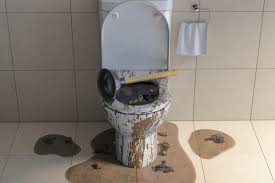Dealing with a clogged toilet is one of the most common household plumbing issues. Whether it’s due to excessive toilet paper, foreign objects, or buildup over time, a clogged toilet can be frustrating and messy. In this guide, we’ll walk you through the steps to fix a clogged toilet and share tips to prevent future blockages.Before you begin, gather the following tools and materials:
- Plunger (preferably a flange plunger)
- Toilet auger (also known as a closet auger)
- Rubber gloves
- Bucket
- Hot water (optional)
- Dish soap (optional)
- Baking soda and vinegar (optional)
Now, let’s dive into the step-by-step process for fixing a clogged toilet:
- Assess the Situation: Before taking any action, check if the toilet is overflowing or just draining slowly. If it’s overflowing, quickly turn off the water supply valve located near the base of the toilet.
- Use a Plunger: Place the plunger over the drain hole, ensuring a tight seal. Push down gently at first to remove air, then plunge vigorously up and down for 15-20 seconds. Repeat if necessary.
- Try Hot Water and Dish Soap: If plunging doesn’t work, pour about a cup of dish soap into the bowl, followed by a gallon of very hot (but not boiling) water. Let it sit for 10-15 minutes before trying to plunge again.
- Use a Toilet Auger: For stubborn clogs, insert the auger into the drain hole and crank the handle clockwise while pushing gently. When you feel resistance, crank the handle to break up or retrieve the clog.
- Natural Solutions: For minor clogs, try pouring 1 cup baking soda followed by 2 cups vinegar into the bowl. Let it fizz for 30 minutes before flushing with hot water.

To prevent future toilet clogs, consider these tips:
- Use less toilet paper or flush multiple times for large amounts
- Avoid flushing anything other than toilet paper and human waste
- Educate children about what shouldn’t be flushed
- Consider installing a bidet to reduce toilet paper use
- Regularly clean your toilet to prevent buildup
For particularly stubborn clogs that resist all these methods, or if you experience frequent clogs, it might indicate a more serious plumbing issue. In these cases, it’s best to contact a professional plumber who can inspect your pipes and identify any underlying problems.Remember that prevention is always better than cure when it comes to clogged toilets. By being mindful of what goes down your toilet and performing regular maintenance, you can save yourself from the hassle and potential embarrassment of dealing with a clogged toilet. Keep your plunger and auger easily accessible, and don’t hesitate to use them at the first sign of slow drainage to prevent a full blockage.
